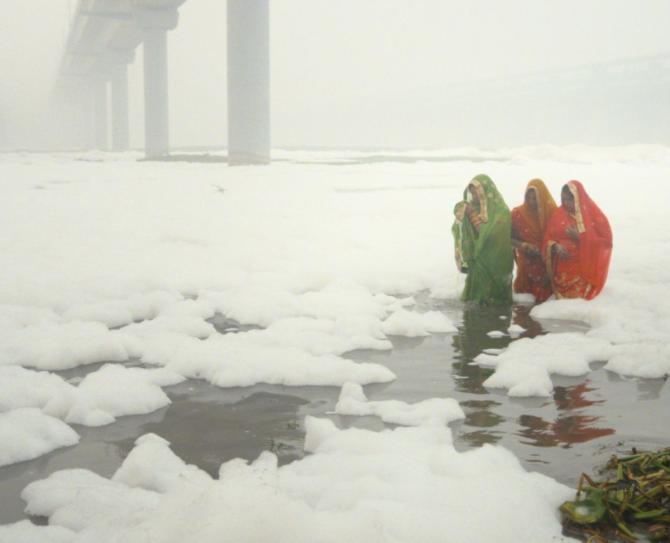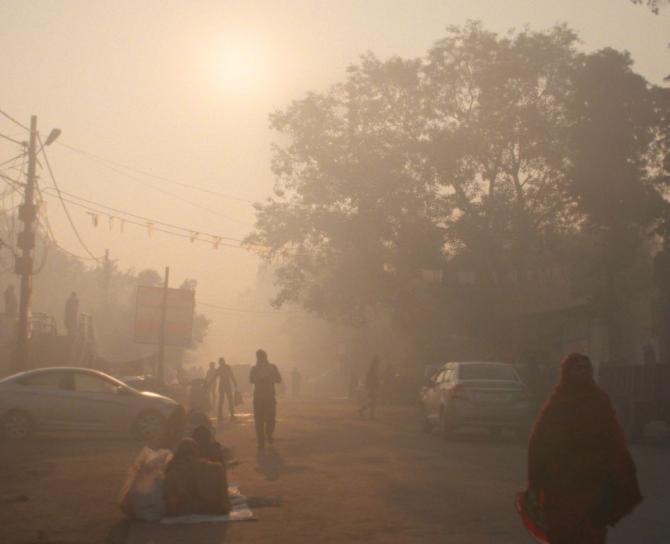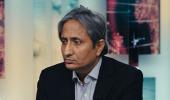'When Covid first struck, the lockdown resulted in clean air in major Indian cities.'
'You were able to see the Himalayan range from Ludhiana.'
'In Delhi, you were seeing deer and stags all over the city because there was no traffic.'
'It was incredible. Nature was waiting to come back.'

In 2016 film-maker Rahul Jain made a compelling documentary about the harsh working conditions of workers in a massive textile mill in Gujarat.
Machines, the film, travelled to many film festivals winning the cinematography award at Sundance, and also recognitions in Zurich, Thessaloniki and the Mumbai Film Festival.
Following the success of Machines, Delhi-born and Berlin-based Jain has dived into one of the most urgent problems facing the planet -- the environmental crisis, with a special focus on India's capital city.
The film Invisible Demons premiered last summer at the Cannes Film Festival in the Cinema for Climate section. It is now streaming on MUBI worldwide.
Invisible Demons is a frightening portrayal of Delhi's reality -- the polluted city, the physical ailments afflicting its citizens (he refers to the airborne particles as 'poison darts piercing lungs'), the unsafe Yamuna river full of pesticides, floods during the monsoon, population explosion, out of control traffic and a lot more.
Jain presents the crisis facing the city without underlining any statements.
It is there for the audience to witness. And like Machines, Invisible Demons also comments on the human cost of development and industrialization.
The Cannes review in Screen International said the film is a 'stark message about the unsustainability of this kind of untrammeled 'progress' in India.'
"I went to do a hike for six weeks in Bhutan. And it's such clean air that I think my immune system must have shut down like it wasn't needed there. Then I took a 50-minute flight from Bhutan to Delhi and as soon as the doors opened I was choking. And the next day I got sick." Rahul Jain tells Rediff.com Senior Contributor Aseem Chhabra.

Rahul, you have talked about falling ill in Delhi and that's what led you to make this film. Can you tell me more, what happened to your health?
After making Machines, I was pretty disturbed and traumatised.
I felt I was missing nature in my life. So I went to do a hike for six weeks in Bhutan. And it's such clean air that I think my immune system must have shut down like it wasn't needed there.
Then I took a 50-minute flight from Bhutan to Delhi and as soon as the doors opened I was choking. And the next day I got sick.
What time of the year was it?
It was October. It was extremely overwhelming.
I felt such a strong reaction, the contrast in the air quality was so severe and it hit me hard, not only physically, but emotionally.
I was thinking about these things earlier as well.
If Machines had not provoked such a strong response, I would not have felt compelled to make another non-fictional film.
I liked the visuals you capture in the film. Just every shot -- the air conditioners, the pesticide smoke, the floods, you put in a lot of thought in capturing each image that also looks nice.
Did you believe that there has to be good art, while you are reminding people about this urgent issue?
I know. Beauty is a very seductive pathway to enter any work of art. Because it is unconditionally pleasurable. And it feels inviting. It's like a seductive trap that you enter very willingly.

I understand you decided to make the film in Delhi since you are originally from here. You actually capture many environment-related issues facing Delhi. Did you do a lot of research?
The environment crisis is in our face. We read about the air quality index, but this is clearly the work of somebody who understands the material without making it dense and boring.
I did a lot of reading, to understand the situation from the point of view of an academic intellect.
I have a strong need to speak things with my family.
My family is very conservative and it took me a long time of struggling, sitting with them on the dining table to realise that I can't say something is wrong without reaching out to them, without trying to communicate with them.
I can't just expect them to agree with me because they are my family.
To get them to where I was, I thought art would be a very feasible modicum.
Everybody feels the pollution. Even if we could communicate with a bird or a butterfly, I am sure they can feel it.
I thought the language should be such that it is easily accessible. Not just to my family, but I thought it should get to the heart of three or four year old.
When I was young I was born in the urban sprawling, concrete jungle megalopolis that Delhi is. And I didn't have a context of what nature was.
For me, nature truly was a gate that you enter that says, 'Welcome to Nature.' I didn't know I was just as much a part of nature.
You know there used to be lovely parks in Delhi. There was Talkatora Garden and Children's Park. India Gate was a beautiful place to walk around. Of course, there is the new Sunder Nursery funded by the Aga Khan Foundation. But mostly that was Delhi of another era.
It is really disturbing how far our city has come from the fundamental elements of nature. Not only is there a population explosion, but there are so many unkempt pieces of land that could be converted into micro forests. And I don't even know who to blame this on.
When I get angry, I don't know where to guide my anger about my alienation with nature.

Talk to me about piecing together the film and the narrative.
When you make a film like this, it has to be without a script.
It's all experiential, which is more memory based. I couldn't write this film. And I do believe that my films are imbued with the present moment, where you are in that moment.
As much as the anxiety it gives to the creator, it is worth the challenge not to know how this will shape up. It forces you to trust your gut instincts.
So I think I was trying to very deeply engage with everything that was already there.
There is no sense of an expose in the film. It's not a hit piece on anybody.
True, and you didn't recreate anything.
Absolutely. If there is an expose, it is the expose on every day.
It's just piecing together the everyday experiences. Maybe it compounds the terror.
I live in Noida, just outside Delhi and I am aware of everything you show in the film, but we shut our minds, even though we breathe the same air. But watching the film I felt I was watching a horror film. The terror is unbelievable.
I wanted to know about the people you talked to and how receptive they were to this film project? One man says that God has changed and man has also changed.
The heat wave in Delhi has increased many fold. What used to be three or four days has now become 50 days.
There is a statistic that shows suicide numbers shoot up as the heat wave goes on.
I spoke to that man at seven in the morning and it was oppressively hot in June. It was already 42 degrees Celsius.
It was so sad that he had to be out at that time of the day to make his daily living.

You were there because you were shooting your film, otherwise, as you say, you are an air conditioner child. You didn't need to step out if you didn't have to. I am the same.
Tell me about the street kids you talk to or rather you show the NDTV anchor interviewing them. They were aware of the environment?
I mean they suffer. Those who live on the streets experience the worst form of environmental crisis.
I did try to speak to the specialists and even politicians. They all had very informed, but disconnected perspectives.
Eventually, I didn't feature them. I wanted the film to be an ode to the everyday common person and not the scientists and politicians.
You show the doctors testing patients and giving them oxygen masks, but you don't ask them questions. That's what I loved about your film. Your camera is just observing. It's right there. But you do make some rare statements such as more than 50 percent of Delhi's kids have lung issues.
But the thing is that nowhere other than the UK do post-mortem reports say the cause of death is pollution.
Otherwise, it is cancer or lung damage. But no one questions why lung damage happens.
I understand why you didn't want to talk to the specialists. But when you make a film like this, then I want to ask you 'Okay Rahul, where do we go from here? How do we get out of this situation?' There are efforts being made by the Delhi government. The Supreme Court has banned crop burning. Do you support those efforts?
From everything I have learned, there is not one single magic bullet.
Just as pollution is caused by many things combined together, I think the answer to the solution has to be manyfold.
Car traffic is one thing we experience in Delhi. The solution has to be the odd-even car decision the government has announced in the past, combined with banning crop burning, combined with not wasting things.

One of the things I realised was that you didn't show how the wealthy live in Delhi with their air purifiers and air conditioners. Although you do mention at the top of the film and in the end that you are an AC child.
I thought that mentioning my own privilege would be enough. I didn't want to create a contrasting dialectic, because it seemed like an obvious thing to do. I thought the suggestion would be enough.
The wealthy in Delhi would be about 15-20 percent of the population. But most of the city is not like that.
You do show two businessmen talking about pollution.
Yes, but they agree that it is impossible to stop the development which will cause more pollution.
The question would be development for who, when we can't even watch a clear sunset?
I live in Noida and often cross the Yamuna river on my way to Okhla. I have seen the foam that you show in the film. Shockingly, people get into that polluted river to perform Chhath Puja.
It's funny that the etymology of Chhath Puja comes from worshiping nature.
It's so ironic but that early morning Chhath Puja scene becomes an Instagram moment. It's not something we cry about.
And this disaster was not created overnight.
It took a few generations to get here. But it is a grim reminder of what can happen when 32 sewers are being released into a city's main river.
Also, it is not just a Delhi problem. It's just that I am from Delhi and I feel the terror on my neck. I feel it in my lungs.
It happened in Mexico City, Beijing, Karachi and in many other cities of the world.
I lived in Los Angeles in the mid-1980s and it used to have a major smog problem. You would drive to LA from Orange County and see a blanket of brown air hanging over the city. But that was a problem was taken care off.
You wonder if things will get better. But then the 1980s LA was in such a mess and they finally solved the problem.
When Covid first struck, the lockdown resulted in clean air in major Indian cities.
You were able to see the Himalayan range from Ludhiana.
In Delhi, you were seeing deer and stags all over the city because there was no traffic.
It was incredible. Nature was waiting to come back. We just need to let nature heal. It's not like all hope is lost.
Feature Presentation: Rajesh Alva/Rediff.com










